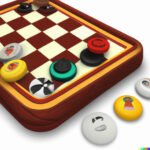The enduring popularity of classic board games spans generations, captivating players both young and old. Among these beloved classics, checkers stands as a prime example, evoking a sense of nostalgia and timeless fun. In this article, we will delve into the world of checkers and explore its origins, rules, strategies, and more. Whether you are a seasoned player or new to the game, prepare to be immersed in the enchanting realm of classic board games like checkers.
Dating back centuries, checkers has stood the test of time and become deeply ingrained in various cultures around the world. To truly understand its charm, it is essential to explore the origins and evolution of this iconic game. From ancient beginnings to modern adaptations, we will uncover how checkers has transformed over time while still retaining its essence.
Understanding the rules and gameplay of checkers is key to fully enjoying this classic board game. With straightforward objectives and easy-to-understand mechanics, players can quickly engage in thrilling matches against friends or family members. Additionally, we will explore essential strategies and tactics for those seeking mastery over their opponents on the checkerboard.
As we embark on this journey through the world of classic board games like checkers, it is worth noting that there are other gems awaiting discovery. In upcoming sections, we will introduce you to similar games such as chess, backgammon, and Othello that possess their own unique features and nuances. However, let us begin our adventure by delving deeper into checkers itself – a timeless pastime that continues to bring joy to countless individuals worldwide.
The Origins and Evolution of Checkers
Checkers, also known as draughts, is a classic board game that has captivated players for centuries. Its origins can be traced back to ancient Egypt and Mesopotamia, where archeological evidence suggests that an early form of the game was played as far back as 3000 BCE. Throughout history, checkers has evolved and adapted to different cultures and regions, becoming a beloved pastime across the world.
The Ancient Origins of Checkers
One of the earliest known versions of checkers was played on a board resembling a modern-day chessboard. This early form of the game was discovered in the city of Ur in present-day Iraq and dates back to around 3000 BCE. The rules were simpler than those we know today, with pieces only moving diagonally forward and capturing by jumping over an opponent’s piece.
Over time, checkers spread to other civilizations, including the Greeks and Romans. The Roman version of checkers, known as Latrunculi or Ludus duodecim scriptorium, featured a larger board and more complex gameplay. It involved careful strategy and planning, making it a precursor to the strategic elements found in modern-day checkers.
The Evolution of Checkers
As medieval Europe embraced board games during the Renaissance period, checkers underwent further changes. The rules were refined, allowing pieces to move both forward and backward on the board. These advancements led to increased gameplay options and depth.
In the 19th century, when board games experienced a surge in popularity due to industrialization and increased leisure time among the middle class, checkers truly came into its own. The standardized rules we are familiar with today were established during this period.
With its simple yet strategic gameplay and accessibility for all ages, checkers has endured throughout centuries of societal changes and technological advancements. It continues to be enjoyed by millions around the world, both in its traditional form and through digital adaptations. Whether played on a physical board or online, the enduring appeal of checkers lies in its ability to bring people together and provide endless hours of entertainment.
Rules and Gameplay of Checkers
Checkers is a classic board game that has been enjoyed by people of all ages and backgrounds for generations. Its simple rules and fast-paced gameplay make it accessible to both casual players and strategic enthusiasts. In this section, we will explore the rules and objectives of checkers, as well as some essential strategies and tactics for a successful game.
The rules of checkers are relatively straightforward. The game is played on an 8×8 grid board with alternating dark and light squares. Each player begins with 12 colored pieces, typically red or black, placed on their side of the board. The objective of checkers is to capture all of your opponent’s pieces or immobilize them so they cannot make any valid moves.
The basic movement of checkers involves diagonally advancing one space forward. However, if a player’s piece reaches the last row on the opponent’s side of the board, it becomes a “king” and gains additional abilities such as being able to move both forwards and backwards. Jumping over an opponent’s piece diagonally allows a player to capture that piece, removing it from the board. Multiple jumps can be made in succession if there are additional capturing opportunities available.
To excel at checkers, players must not only focus on capturing their opponent’s pieces but also anticipate their moves and strategize accordingly. One key strategy is creating chains or sequences of multiple captures in order to gain a positional advantage. This involves planning ahead and setting up situations where the opponent will be forced to sacrifice pieces.
Additionally, controlling the center of the board is crucial in checkers as it allows for greater mobility and more capturing opportunities. Players should strive to establish dominance over the central squares while simultaneously defending their own pieces from being captured.
| Rules | Data |
|---|---|
| Board Size | 8×8 |
| Starting pieces | 12 per player |
| Movement | Diagonally forward, or diagonally forward and backward for kings |
| Capturing | Jumping over opponent’s piece diagonally |
| Objective | Capture all opponent’s pieces or immobilize them from making any valid moves. |
As with any game, checkers also has a set of common mistakes to avoid. One common error is failing to anticipate the opponent’s moves and falling into their traps. It is important to carefully analyze the board and consider multiple possible scenarios before making a move.
Additionally, sacrificing your own pieces without gaining a clear advantage in return can leave you at a disadvantage. Keeping an eye out for capturing opportunities while minimizing your own vulnerabilities is key to success in checkers.
By understanding the rules and basic strategies of checkers, players can fully immerse themselves in this timeless classic and enjoy hours of strategic gameplay. Whether playing with friends and family or competing in tournaments, checkers provides endless entertainment and challenges that have stood the test of time.
Strategy and Tips for Winning at Checkers
Checkers is a game known for its simplicity, yet it also requires strategic thinking and careful planning to outmaneuver opponents and come out on top. In this section, we will explore various strategies and offer tips for those who are looking to improve their gameplay and increase their chances of winning at checkers.
Mastering the Basics
Before diving into advanced strategies, it’s important to have a solid understanding of the basic rules and gameplay of checkers. Each player starts with 12 pieces arranged on opposite sides of the board. The aim is to capture all of your opponent’s pieces or block them from making any further moves.
A key concept to remember is that kings are more powerful than regular pieces. A piece becomes a king when it reaches the last row on the opponent’s side of the board. Kings can move diagonally in both directions and can therefore cover more ground and strategically position themselves for capturing multiple pieces.
Controlling the Center
In checkers, controlling the center of the board gives you a significant advantage. By occupying these central squares, you limit your opponent’s mobility options, restrict their ability to crown their pieces, and create opportunities for capturing multiple enemy pieces.
At the start of the game, try to make moves that allow you to maintain control over as many central squares as possible. This will force your opponent into defensive positions early on, giving you an edge in dictating the flow of the game.
Planning Ahead
Successful checkers players always think several moves ahead and anticipate their opponent’s reactions. Regularly reassessing the board state during gameplay helps maintain awareness of potential threats or opportunities.
One effective strategy is called “forcing.” This involves creating situations where your opponent has no option but to make specific moves that benefit you strategically. By forcing your opponents into unfavorable positions, you can steadily gain an advantage and put yourself in a winning position.
Remember, it’s not just about capturing your opponents’ pieces but also strategically positioning your own. Sacrificing a piece to set up a multiple capture scenario or gain control of key squares can often be a worthwhile strategy.
By mastering the basic rules, controlling the center of the board, and planning ahead, you are well on your way to improving your chances of winning at checkers. It’s important to practice these strategies regularly to develop your skills and adapt them to different opponents’ playstyles. Whether playing casually with friends or participating in competitive tournaments, honing your skills will lead to more enjoyable and successful gameplay experiences.
Classic Board Games Similar to Checkers
If you enjoy playing checkers and are looking for other classic board games with similar gameplay and appeal, you’re in luck. There are several timeless titles that offer strategic challenges and hours of entertainment. Here are some classic board games that share similarities with checkers:
- Chess: Considered the ultimate strategy game, chess shares some similarities with checkers in terms of capturing opponent’s pieces and moving across a grid-like board. However, chess is widely regarded as more complex and requires a deeper understanding of strategy and planning. It features unique pieces with different movement patterns, making each match a mentally stimulating battle.
- Backgammon: Backgammon is another classic board game that encompasses elements of strategy and luck. Like checkers, it is played on a square board, but instead of capturing pieces, the goal is to be the first to bear off all your checkers from the board. Backgammon offers a balance between skillful decision-making and calculated risk-taking.
- Othello (also known as Reversi): Othello is a two-player game that involves placing discs on a grid-like board. The objective is to outmaneuver your opponent by flipping their discs to match your color through strategic placement. Othello shares some similarities with checkers in terms of capturing opponent’s pieces but adds its own twist by introducing the concept of flipping instead of removing them from the board.
These classic board games provide endless opportunities for fun, challenge, and friendly competition. Whether you prefer the complexity of chess, the mix of strategy and luck in backgammon, or the tactical maneuvering in Othello, these games are sure to test your skills while keeping you engaged for hours on end.
So gather your friends or family members for an exciting gaming session filled with nostalgic charm and social interactions.
Classic Board Games for Kids
Classic board games have a special place in the hearts of both children and adults. They provide an opportunity for family bonding, strategic thinking, and endless hours of entertainment. Among these beloved classics, checkers stands as one of the most accessible and enjoyable games for kids of all ages.
The Benefits of Introducing Classic Board Games Like Checkers to Children
Introducing classic board games to children can have numerous benefits beyond just entertainment. Checkers, in particular, offers several advantages for kids’ cognitive, social, and emotional development.
Firstly, playing checkers helps improve critical thinking skills. The game requires players to analyze the board, strategize their moves, and anticipate their opponent’s moves. It promotes logical reasoning, spatial awareness, and decision-making abilities.
Additionally, checkers fosters social interaction and sportsmanship. Playing this game with friends or family members creates opportunities for communication, collaboration, turn-taking, and respectful competition. Children learn valuable lessons about winning graciously and accepting defeat with grace.
Teaching kids how to play checkers
When introducing checkers to children who may be unfamiliar with the game, it is important to simplify the rules and make it enjoyable for them. Here are some tips:
- Start with a simplified version: Begin by teaching your child the basic rules of checkers without focusing on advanced strategies such as double jumps or crowning pieces.
- Use visual aids: Utilize visual cues like colored pieces or symbols on the board to assist your child in understanding different moves.
- Be patient and encouraging: Children may take time to grasp the concepts of the game fully. Encourage their progress and provide constructive feedback along the way.
- Practice makes perfect: To build their skills further, dedicate regular practice sessions where they can play against you or other children at their skill level.
- Make it fun: Incorporate elements of storytelling or themes that resonate with your child. This will make the experience more enjoyable and keep them engaged.
| Benefits of Introducing Classic Board Games Like Checkers to Children |
|---|
| – Improves critical thinking skills |
| – Fosters social interaction and sportsmanship |
| – Promotes logical reasoning and decision-making abilities |
The Rise of Online Gaming
In this digital age, online gaming has become a prevalent form of entertainment for people of all ages. Classic board games like checkers have also made their way into the digital realm, providing players with a convenient and accessible way to enjoy this timeless game. The rise of online gaming platforms has not only made checkers more accessible to players around the world but has also introduced new features and adaptations that enhance the overall gaming experience.
One of the primary advantages of playing checkers online is the ability to connect with players from different parts of the globe. Online platforms offer multiplayer modes where individuals can challenge opponents from anywhere in the world, breaking down geographical barriers. This opens up a whole new level of competition and allows players to test their skills against opponents they may have never encountered otherwise.
Furthermore, digital adaptations of checkers often include additional features that enhance gameplay. Some platforms provide tutorials or interactive guides for beginners who may be unfamiliar with the rules or strategies of the game. Others offer different variations of checkers, such as international draughts or Turkish draughts, which introduce new rules or dimensions to keep the game fresh and exciting.
Moreover, playing checkers online provides opportunities for both casual play and competitive tournaments. Many online platforms organize regular tournaments where skilled players can showcase their abilities and compete for recognition and prizes. These tournaments attract a dedicated community of checkers enthusiasts who value the competitive aspect of the game and strive to improve their skills.
Checkers Tournaments and Competitive Play
Checkers may be a classic board game enjoyed by families and friends around the world, but it is also a game that can be played competitively at tournaments. Checkers tournaments offer players the opportunity to test their skills against others and showcase their strategic abilities. In this section, we will explore the competitive scene in checkers and provide information on how to get involved in local, national, or even international checkers tournaments.
Overview of Checkers Tournaments
Checkers tournaments are organized events where players compete against each other for prizes and recognition. These tournaments are typically structured with various rounds, leading up to a finale where the best players face off for the championship title. Tournaments can take place at different levels, ranging from local community events to national or even international competitions.
One popular format of checkers tournament play is known as “straight checkers.” This format follows traditional rules of checkers where players aim to capture all of their opponent’s pieces or block them from making any legal moves. Another format is called “three-move restriction,” which introduces a time limit per move, adding an additional layer of strategy to the game. Regardless of the format, checkers tournaments require skillful planning, sharp thinking, and precise execution.
Getting Involved in Checkers Tournaments
If you’re interested in testing your skills on a competitive level in checkers, there are several ways to get involved in tournaments. The first step is to look for local checkers clubs or organizations that host regular tournaments in your area. These clubs often welcome new players and can provide guidance on how to improve your gameplay.
Additionally, many national and international organizations organize larger-scale checkers tournaments. These events typically have stricter entry requirements but offer the opportunity to compete at a higher level and gain exposure within the competitive checkers community.
It’s important to practice and refine your skills before entering a tournament. Regularly playing against strong opponents and studying advanced strategies can significantly improve your game. Joining online checkers communities and participating in virtual tournaments can also provide valuable experience and help you connect with fellow checkers enthusiasts.
Checkers tournaments provide an exciting platform for players to engage in competitive play, hone their skills, and meet like-minded individuals who share their passion for the game. Whether you’re a casual player looking to challenge yourself or a dedicated enthusiast aiming for championship glory, exploring the world of checkers tournaments can lead to thrilling experiences and new opportunities within the checkers community.
The Enduring Appeal of Classic Board Games Like Checkers
Classic board games have a special place in our hearts, offering a timeless appeal that transcends generations. These beloved games hold the power to bring people together, fostering social connections and creating lasting memories. One prime example of a classic board game that has stood the test of time is checkers.
Checkers, also known as draughts in some parts of the world, has a long and fascinating history. The origins of this game can be traced back over 5,000 years to ancient civilizations like Egypt and Mesopotamia. In its earliest form, checkers was played using pebbles on carved boards. Over time, it evolved into the familiar game we know today with its iconic red and black pieces on a square board.
The enduring appeal of checkers lies in its simplicity and accessibility. The rules are easy to understand, making it suitable for players of all ages and skill levels. The objective is straightforward: to capture all of your opponent’s pieces or block their moves until they cannot make any more valid moves. However, beneath its seemingly simple gameplay lies a depth of strategy and tactics that can keep players engaged for hours on end.
Whether played casually with family and friends or competitively at tournaments, checkers continues to captivate players around the world. Its enduring popularity can be attributed to factors such as its quick playtime, intellectual challenges, and the opportunity for friendly competition. By bringing people together around a physical board, checkers creates an atmosphere that encourages social interaction and bonding.
Conclusion
In conclusion, classic board games like checkers hold a special place in our hearts and continue to bring joy and excitement to people of all ages. The timeless appeal of these beloved games lies in their ability to create lasting memories and connections with others. Whether it’s the simplicity of the rules or the strategic depth they offer, classic board games have stood the test of time and continue to be enjoyed by generations.
By revisiting the classics like checkers, we can experience the nostalgic joy of gathering around a board game and engaging in friendly competition. There is something magical about sitting down with friends or family members, rolling the dice or moving the pieces, and immersing ourselves in a world removed from screens and technology. Classic board games provide an opportunity for face-to-face interaction, laughter, and bonding that is difficult to replicate in today’s digital age.
So why not dust off your old checkers set or explore other classic board games? Rediscovering these timeless favorites can reignite that spark of joy and excitement that comes with a well-played move or a hard-fought victory.
Whether you’re teaching your children how to play checkers or competing in a local tournament, classic board games have a way of bringing people together and creating cherished memories that will last a lifetime. So gather your loved ones, clear off the kitchen table, and embark on an adventure through time with classic board games like checkers.
Frequently Asked Questions
What old board game is like checkers?
One old board game that is like checkers is the game of “draughts.” Also known as “English draughts,” this classic board game has a similar playing style to checkers, where opponents take turns moving their pieces diagonally across the board.
The objective of draughts is also quite similar to checkers, where the goal is to capture all of the opponent’s pieces or block them in such a way that they cannot make any valid moves. While there may be slight variations in rules and board sizes depending on different regions, draughts provides a comparable experience to those who enjoy playing checkers.
What are some old board games?
There are numerous old board games that have been enjoyed by generations before us. One popular example is “Chess,” which dates back over a thousand years and involves strategic gameplay using different types of pieces aiming to capture the opponent’s king. Another classic board game is “Backgammon,” which originated over 5,000 years ago and combines elements of luck and strategy as players move their pieces around a unique board trying to bear them off first.
Other well-known old board games include “Monopoly,” “Scrabble,” “Clue,” and “Risk,” among many others. These vintage games continue to entertain people today, highlighting the enduring appeal of traditional tabletop gaming.
What game is like checkers but not checkers?
The game that resembles checkers but is not actually checkers is called “Chinese Checkers.” Despite its name, Chinese Checkers did not originate from China but was rather created in Germany during the late 19th century as a modified version of an older American game called Halma. Unlike traditional checkers, Chinese Checkers utilizes a star-shaped board with colored triangles arranged in a hexagonal pattern.
Each player aims to move their set of marbles from one side of the star-shaped board to the opposite side by hopping over adjacent marbles or skipping empty spaces. Although slightly more complex than traditional checkers, Chinese Checkers provides a similar enjoyment of strategic movement and capturing opponent’s pieces.

I love playing all kinds of games – from classics like Monopoly to modern favourites like Ticket to Ride.
I created this blog as a way to share my love of board games with others, and provide information on the latest releases and news in the industry.





